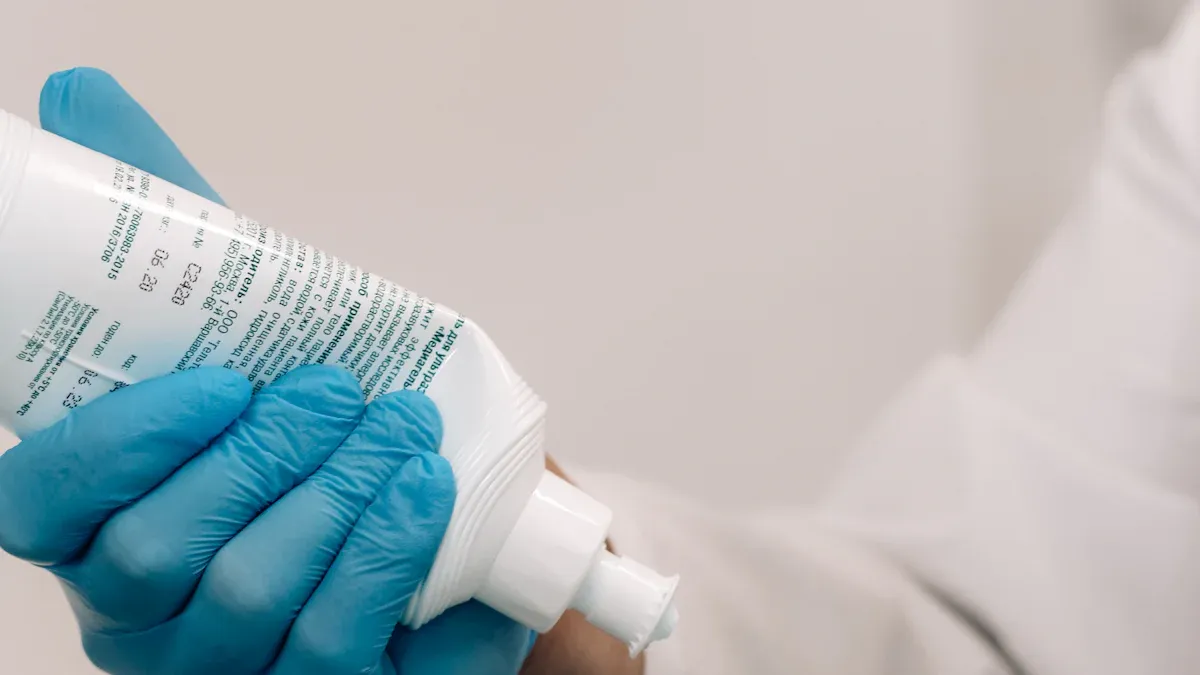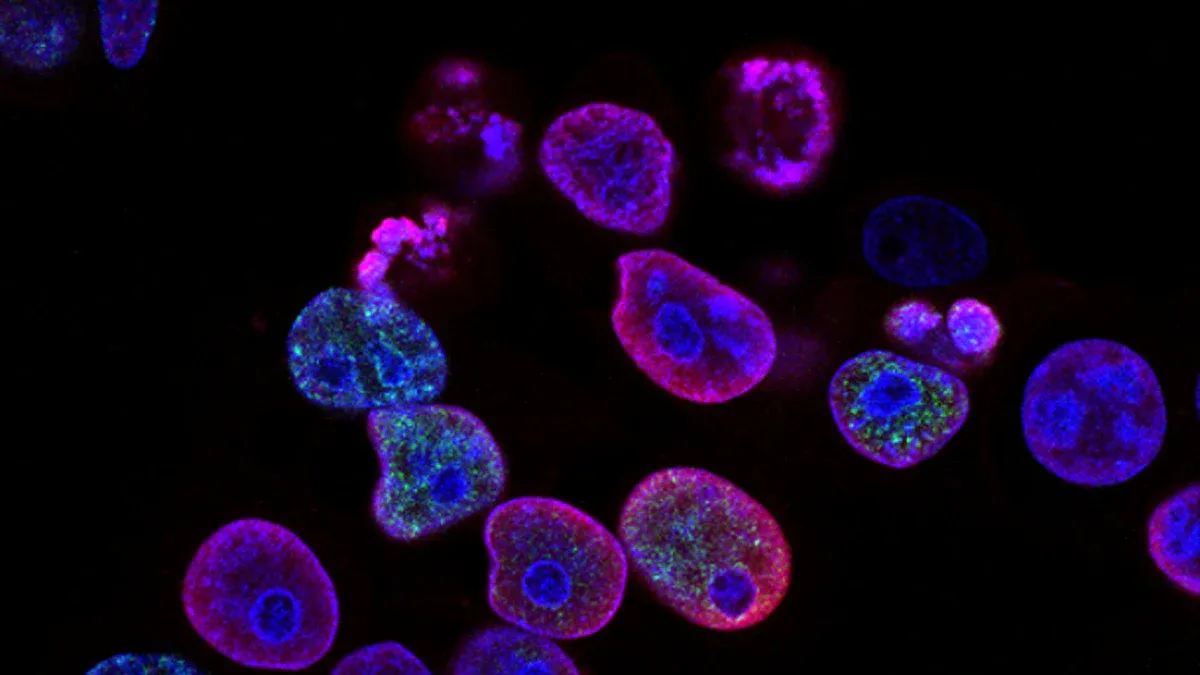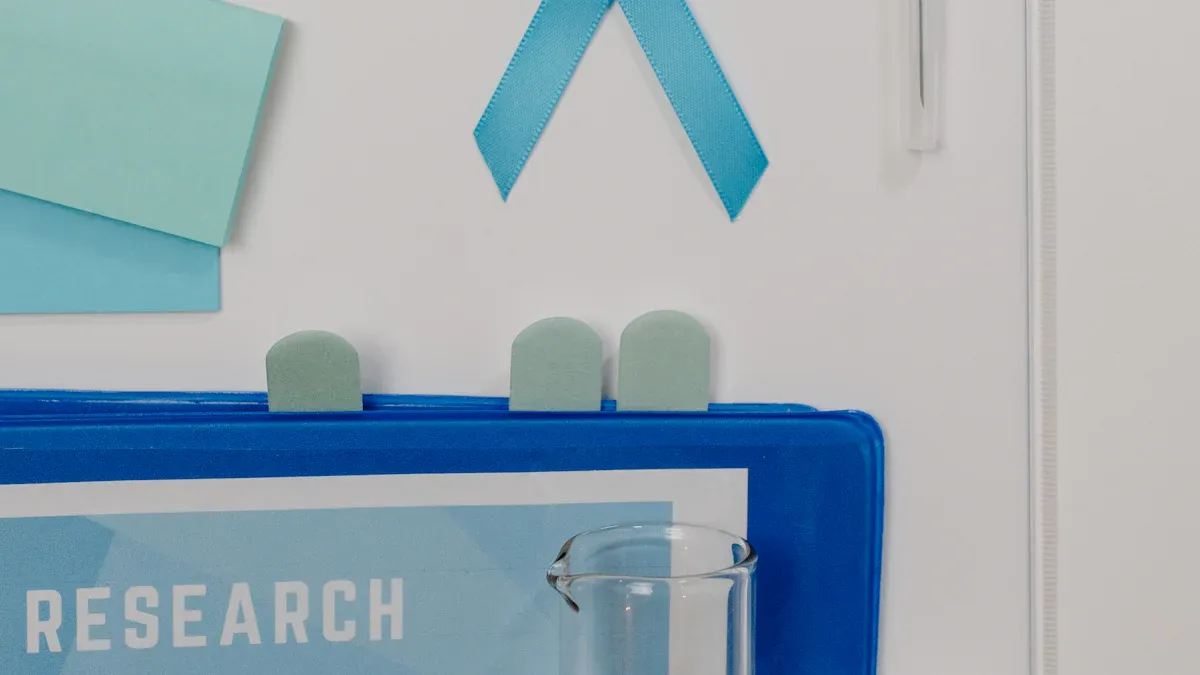How Antibody-Drug Conjugates Fight Cancer Effectively

Antibody-drug conjugates (ADCs) represent a revolutionary approach to cancer treatment. These therapies combine the precision of antibodies with the strength of cytotoxic drugs to target cancer cells directly. You benefit from this targeted approach because it minimizes harm to healthy tissues. Recent studies show that ADCs achieve a pooled overall response rate of 58%, demonstrating their effectiveness. Adverse effects, mainly involving the skin and digestive system, remain manageable. This innovative therapy offers a promising solution for improving outcomes in cancer care while reducing side effects.
Key Takeaways
ADCs mix antibodies with strong drugs to attack cancer cells directly. This helps protect healthy tissues from harm.
This focused method works better and causes fewer side effects than regular chemotherapy.
ADCs can be adjusted to treat different cancers, making them useful and flexible in cancer treatment.
ChemExpress helps improve ADCs by giving top-quality materials and aiding research.
Even though making ADCs is expensive, new ideas bring hope for better cancer treatments.
What Are Antibody-Drug Conjugates?
Antibody-drug conjugates (ADCs) are a cutting-edge form of targeted cancer therapy. They combine the precision of antibodies with the power of cytotoxic drugs to attack cancer cells while sparing healthy tissues. To understand how ADCs work, you need to explore their three main components.
Components of ADCs
The Antibody: Precision Targeting
The antibody in an ADC acts as a guide. It is typically a monoclonal antibody designed to recognize specific antigens on the surface of cancer cells. This precision ensures that the therapy targets only the intended cells, reducing the risk of harming healthy tissues. Enhancing target antigen selection is crucial for ADC effectiveness. Ideal antigens are extracellular, allowing the antibody to bind efficiently, and they promote internalization to deliver the cytotoxic payload directly into cancer cells.
The Linker: Ensuring Stability and Release
The linker connects the antibody to the cytotoxic payload. It plays a critical role in maintaining the stability of the ADC in your bloodstream. A well-designed linker ensures that the payload remains inactive until the ADC reaches its target. Once inside the cancer cell, the linker releases the drug, maximizing its therapeutic effect.
The Drug: Delivering Potent Therapy
The cytotoxic payload is the component that destroys cancer cells. These drugs are highly potent, often 100 to 1,000 times stronger than traditional chemotherapy agents. By delivering the drug directly to the cancer cells, ADCs achieve a high therapeutic index, improving treatment outcomes.
How ADCs Differ from Traditional Cancer Therapies
Targeted Cancer Therapy vs. Broad Chemotherapy
Traditional chemotherapy affects both cancerous and healthy cells, leading to widespread side effects. ADCs, as a form of targeted cancer therapy, deliver chemotherapy directly to cancer cells. This approach minimizes systemic toxicity and spares healthy tissues, making the treatment more efficient.
Reduced Side Effects and Improved Patient Outcomes
ADCs offer a better safety profile compared to traditional therapies. Advances in antibody engineering and linker technology have expanded the therapeutic window, allowing ADCs to treat a broader range of cancers. These improvements result in fewer side effects and a better quality of life for patients undergoing therapy.
ADCs represent a significant leap forward in cancer treatment. Their ability to combine precision targeting with potent drug delivery makes them a powerful tool in the fight against cancer.
How Do Antibody-Drug Conjugates Work?

Mechanism of Action
Binding to Cancer Cell Receptors
Antibody-drug conjugates (ADCs) act as precision-guided "biological missiles" targeting cancer cells. The antibody component binds to specific antigens on the surface of cancer cells. This binding ensures that the therapy focuses on the intended target, sparing healthy tissues. The efficiency of this process depends on the binding affinity between the antibody and the tumor cell antigens. Optimal affinity balances rapid absorption and anticancer potency, making ADCs highly effective in targeted cancer therapy.
Internalization and Drug Activation
Once the ADC binds to the cancer cell, it undergoes internalization through antigen-dependent endocytosis or antigen-independent pinocytosis. Inside the cell, the ADC forms early endosomes, which mature into late endosomes and fuse with lysosomes. The cytotoxic payload is then released in the lysosomes, where it becomes active. This process leads to the destruction of cancer cells by targeting critical structures like DNA or microtubules. Miniaturized antibodies, due to their smaller size, show improved penetration into solid tumors, enhancing the efficacy of ADC therapy.
Destroying Cancer Cells with Precision
The released payload induces apoptosis, or programmed cell death, in cancer cells. ADCs also create a bystander effect, where the released drug affects nearby cancer cells, further enhancing the therapy's impact. This dual action not only destroys the primary target but also alters the tumor microenvironment, making ADCs a powerful tool in cancer treatment.
ChemExpress’s Role in ADC Development
Expertise in ADC Component Manufacturing
ChemExpress plays a pivotal role in advancing ADC technology. The company specializes in manufacturing high-quality components, including antibodies, linkers, and cytotoxic payloads. Their expertise ensures that each component meets stringent regulatory standards, supporting the clinical development of ADCs. ChemExpress’s innovative approach to linker synthesis and conjugation processes has positioned them as a leader in the ADC sector.
Supporting Research and Development in Targeted Cancer Therapy
ChemExpress collaborates with researchers worldwide to drive innovation in ADC therapy. By providing comprehensive services, from early discovery to commercialization, they streamline the development process. The company’s contributions include supplying high-potency APIs and offering regulatory CMC support. These efforts accelerate the clinical development of ADCs, ensuring that new therapies reach patients faster.
Aspect | Details |
|---|---|
Market Size | |
Growth Rates | Projected growth rates in the ADC sector |
Competitive Landscape | ChemExpress’s position among competitors |
ChemExpress’s commitment to quality and innovation continues to shape the future of antibody-drug conjugates, making them a trusted partner in the fight against cancer.
Why Are Antibody-Drug Conjugates Effective in Fighting Cancer?
Precision Targeting of Cancer Cells
Avoiding Damage to Healthy Tissues
Antibody-drug conjugates (ADCs) excel in precision targeting, acting like "biological missiles" that deliver cytotoxic drugs directly to cancer cells. The antibody component identifies specific antigens on the surface of cancer cells, ensuring the therapy spares healthy tissues. This targeted approach minimizes off-target effects, reducing the risk of damage to non-cancerous cells. ADCs also extend their focus beyond tumor cell antigens to components within the tumor microenvironment, such as the stroma and vasculature. By disrupting growth factors produced by matrix-resident cells, ADCs enhance their ability to induce cancer cell death effectively.
Enhancing Treatment Efficacy
ADCs combine the potent killing effects of chemotherapy with the precision of antibody drugs. This synergy enhances therapeutic efficacy while reducing side effects. The stability of the linker, the potency of the payload, and the expression levels of target antigens all contribute to the success of ADCs. By accurately identifying and binding to cancer cells, ADCs ensure the cytotoxic payload is delivered where it is needed most, maximizing their impact on cancer treatment.
Reduced Side Effects
Lower Toxicity Compared to Traditional Chemotherapy
Traditional chemotherapy often harms healthy cells, leading to severe side effects. ADCs, however, deliver their cytotoxic payloads directly to cancer cells, significantly lowering systemic toxicity. A systematic review of 13 clinical trials involving 4,246 patients revealed that the incidence of fatal adverse events was lower for those treated with HER2-targeted ADCs (0.078%) compared to the control group (0.095%). This data highlights the safety profile of ADCs as a cancer therapy.
Improved Quality of Life for Patients
By reducing toxicity, ADCs improve the quality of life for patients undergoing cancer treatment. Patients experience fewer debilitating side effects, such as nausea and hair loss, which are common with traditional therapies. This improvement allows patients to maintain a better overall well-being during their treatment journey.
Versatility in Treating Various Cancer Types
Customizable Antibodies for Specific Cancers
ADCs offer remarkable versatility in cancer treatment. Researchers can customize antibodies to target specific antigens expressed in different cancer types. For example, ADCs targeting ERBB2 have proven effective against ERBB2-overexpressed cancers, including breast cancer. This adaptability makes ADCs a valuable tool in addressing diverse cancer challenges.
Potential for Combination Therapies
ADCs also show promise in combination therapies. They can work alongside other treatments, such as immunotherapy or radiation, to enhance overall efficacy. Clinical trials have demonstrated ADCs' broad applicability, with 53 trials involving unspecified solid tumors and 34.8% exploring multiple indications simultaneously. This versatility underscores the potential of ADCs to revolutionize cancer therapy.
ADCs represent a powerful advancement in cancer therapy. Their precision targeting, reduced side effects, and adaptability make them an effective solution for enhancing ADC efficacy and improving patient outcomes.
Examples of Antibody-Drug Conjugates in Cancer Treatment

FDA-Approved ADCs
Trastuzumab Emtansine (Kadcyla) for HER2-Positive Breast Cancer
Trastuzumab emtansine, also known as Kadcyla, was the first antibody-drug conjugate approved for solid tumors. It received FDA approval in 2013 for treating HER2-positive metastatic breast cancer. This therapy combines trastuzumab, a monoclonal antibody targeting HER2, with a potent cytotoxic drug. Kadcyla delivers its payload directly to cancer cells, reducing harm to healthy tissues. Its approval marked a significant milestone in cancer therapy, offering a targeted option for patients with advanced breast cancer.
Brentuximab Vedotin (Adcetris) for Hodgkin Lymphoma
Brentuximab vedotin, marketed as Adcetris, is another FDA-approved ADC. It targets CD30, a protein expressed in Hodgkin lymphoma and other cancers. Clinical trials, such as the ALCANZA study, demonstrated its efficacy in treating cutaneous T-cell lymphoma. Adcetris has become a vital therapy for patients with relapsed or refractory Hodgkin lymphoma, providing a more focused and effective treatment option.
Year | ADC Name | Indication |
|---|---|---|
2013 | Kadcyla (trastuzumab emtansine) | HER2-positive metastatic breast cancer |
2000 | Mylotarg (gemtuzumab ozogamicin) | Acute myeloid leukemia (AML) |
Total ADC Approvals | 14 ADC drugs approved for various cancers |
Emerging ADCs in Clinical Trials
Promising Results in Solid Tumors
Emerging ADCs show great promise in treating solid tumors. Clinical trials have revealed their potential to improve outcomes in cancers like lung, ovarian, and gastric cancer. Researchers are exploring combinations of ADCs with immune checkpoint inhibitors to enhance efficacy. These trials aim to move ADCs into earlier lines of therapy, offering hope for patients with limited treatment options.
Expanding Applications in Rare Cancers
ADCs are also making strides in rare cancers. Clinical trials are investigating their use in conditions like triple-negative breast cancer and certain sarcomas. Over 50 phase 3 trials are currently underway, with many focusing on combination therapies. These efforts highlight the versatility of ADCs and their potential to replace conventional chemotherapies in the future.
ChemExpress’s Contributions to ADC Innovation
Supplying High-Quality ADC Components
ChemExpress plays a crucial role in advancing ADC technology. The company provides high-quality components, including antibodies, linkers, and cytotoxic payloads. Their expertise ensures that these components meet stringent regulatory standards, supporting the development of effective ADC therapies.
Collaborating with Researchers to Advance ADC Therapies
ChemExpress collaborates with researchers worldwide to accelerate ADC innovation. By offering comprehensive services, from early discovery to commercialization, they help streamline the development process. Their contributions include supplying high-potency APIs and supporting clinical trials, ensuring that new therapies reach patients faster.
ADCs represent a transformative approach to cancer therapy. With FDA-approved options like Kadcyla and Adcetris, and promising candidates in clinical trials, ADCs continue to redefine how you fight cancer.
Benefits and Limitations of Antibody-Drug Conjugates
Benefits of ADCs
Targeted Delivery of Potent Drugs
Antibody-drug conjugates (ADCs) deliver powerful drugs directly to cancer cells. This precision ensures that the therapy focuses on destroying harmful cells while sparing healthy tissues. The antibody component acts like a GPS, guiding the drug to its target. This targeted delivery enhances the effectiveness of the treatment and reduces unnecessary exposure to non-cancerous areas.
Reduced Systemic Toxicity
Traditional cancer treatments often harm healthy cells, causing severe side effects. ADCs minimize this issue by releasing their cytotoxic payload only inside cancer cells. This approach significantly lowers systemic toxicity, making the therapy safer for you. Patients undergoing ADC treatment often experience fewer side effects compared to those receiving conventional chemotherapy.
Potential for Personalized Medicine
ADCs offer the potential for personalized therapy. Researchers can design antibodies to target specific antigens unique to your cancer type. This customization allows for a more tailored approach, improving the chances of successful treatment. Personalized ADCs represent a step forward in precision medicine, offering hope for better outcomes.
Limitations and Challenges
High Development Costs
Developing ADCs involves significant investment. The process requires advanced technology and extensive research. These factors contribute to the high costs of bringing ADCs to market. However, the long-term benefits often outweigh the initial expenses.
Complex Manufacturing Processes
The production of ADCs is highly complex. Each component—antibody, linker, and drug—must meet strict quality standards. The conjugation process also requires precision to ensure stability and efficacy. These challenges make ADC manufacturing a demanding task.
Resistance Mechanisms in Cancer Cells
Cancer cells can develop resistance to ADCs over time. This resistance reduces the effectiveness of the therapy. Researchers are actively studying these mechanisms to develop strategies that overcome resistance and improve treatment outcomes.
How ChemExpress Addresses ADC Challenges
Streamlining ADC Production
ChemExpress simplifies the production of ADCs by offering end-to-end solutions. Their expertise in linker synthesis, antibody development, and conjugation ensures a seamless process. By streamlining production, ChemExpress helps you access high-quality ADCs faster.
Providing Cost-Effective Solutions for Research and Development
ChemExpress supports researchers by providing cost-effective solutions. Their comprehensive services, from early discovery to commercialization, reduce the financial burden of ADC development. This approach accelerates innovation and ensures that new therapies reach patients efficiently.
ChemExpress’s commitment to quality and innovation makes them a trusted partner in advancing ADC technology. Their efforts address key challenges, paving the way for more accessible and effective cancer therapies.
Antibody-drug conjugates (ADCs) are transforming cancer treatment by combining precision targeting with powerful therapy. You benefit from their ability to deliver drugs directly to cancer cells, improving outcomes while reducing side effects. Despite challenges like high costs, ongoing innovation continues to advance ADC technology. Organizations like ChemExpress play a vital role in supporting this progress. ADCs represent a promising future in cancer therapy, offering hope for more effective and personalized solutions in oncology.
FAQ
What makes antibody-drug conjugates (ADCs) different from traditional cancer treatments?
ADCs target cancer cells directly using antibodies, sparing healthy tissues. Traditional treatments like chemotherapy affect both cancerous and healthy cells, leading to more side effects. ADCs combine precision targeting with potent drugs, improving treatment outcomes.
Are ADCs effective for all types of cancer?
ADCs work best for cancers with specific antigens that antibodies can target. Researchers continue to develop ADCs for various cancer types, including rare and aggressive forms. Their adaptability makes them a promising option for many patients.
How are ADCs administered to patients?
Doctors typically administer ADCs through intravenous (IV) infusion. The process ensures the therapy reaches your bloodstream and targets cancer cells effectively. Your healthcare team will monitor you during and after the infusion for any side effects.
Can ADCs be used with other cancer therapies?
Yes, ADCs often complement other treatments like immunotherapy or radiation. Combining therapies can enhance overall effectiveness. Clinical trials frequently explore ADCs in combination with other approaches to improve patient outcomes.
Are there any side effects of ADC therapy?
ADCs have fewer side effects compared to traditional chemotherapy. However, you might experience mild reactions like fatigue or nausea. Your doctor will manage these effects to ensure your comfort during treatment.